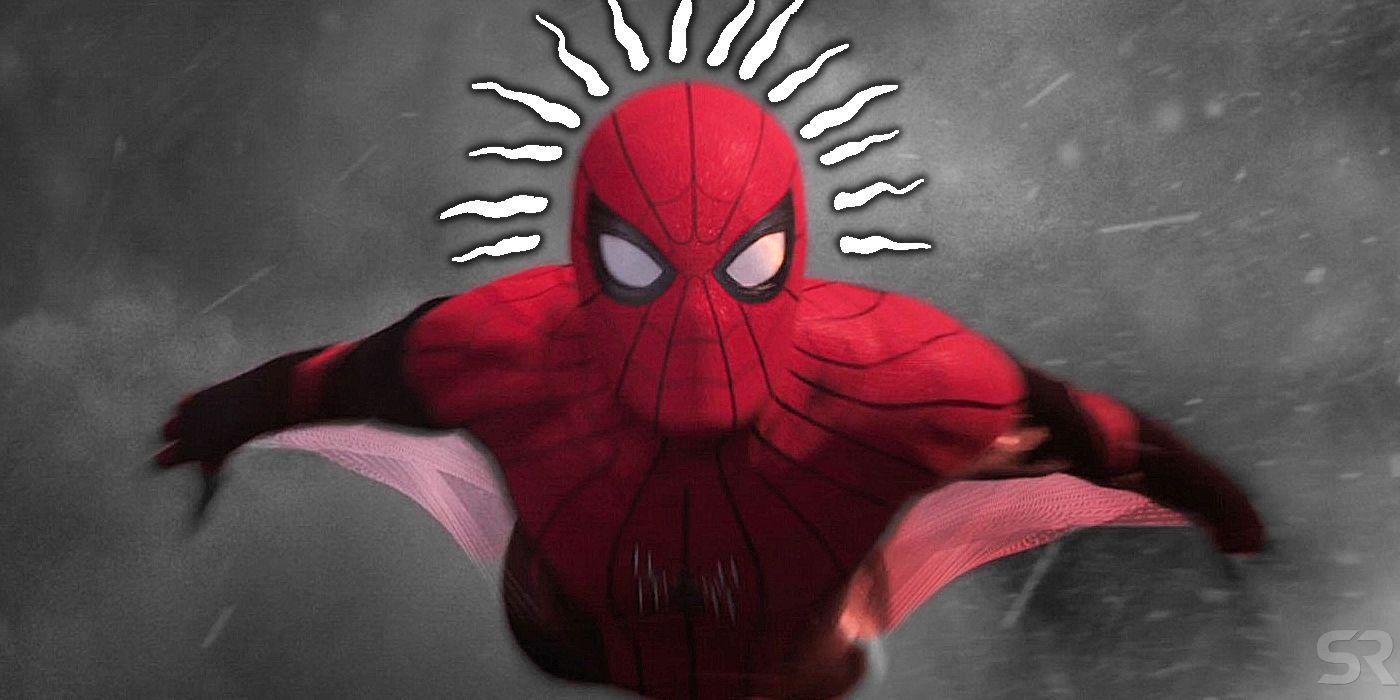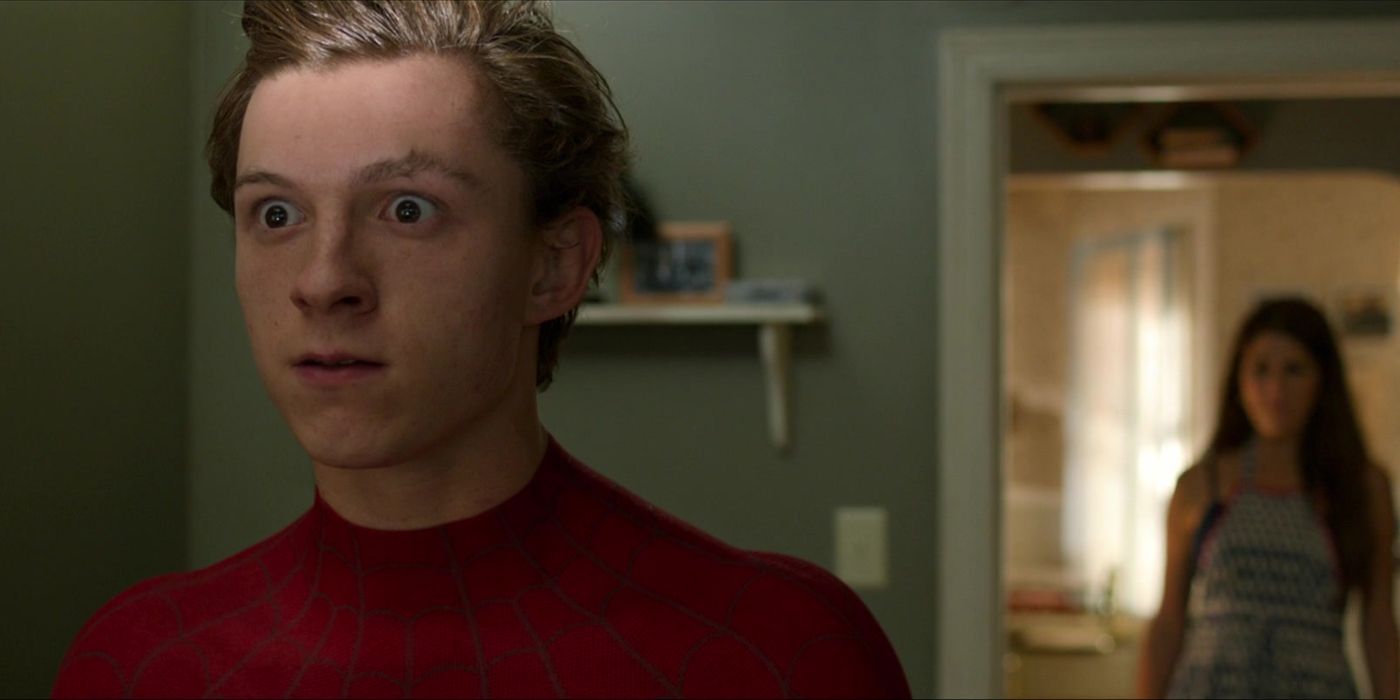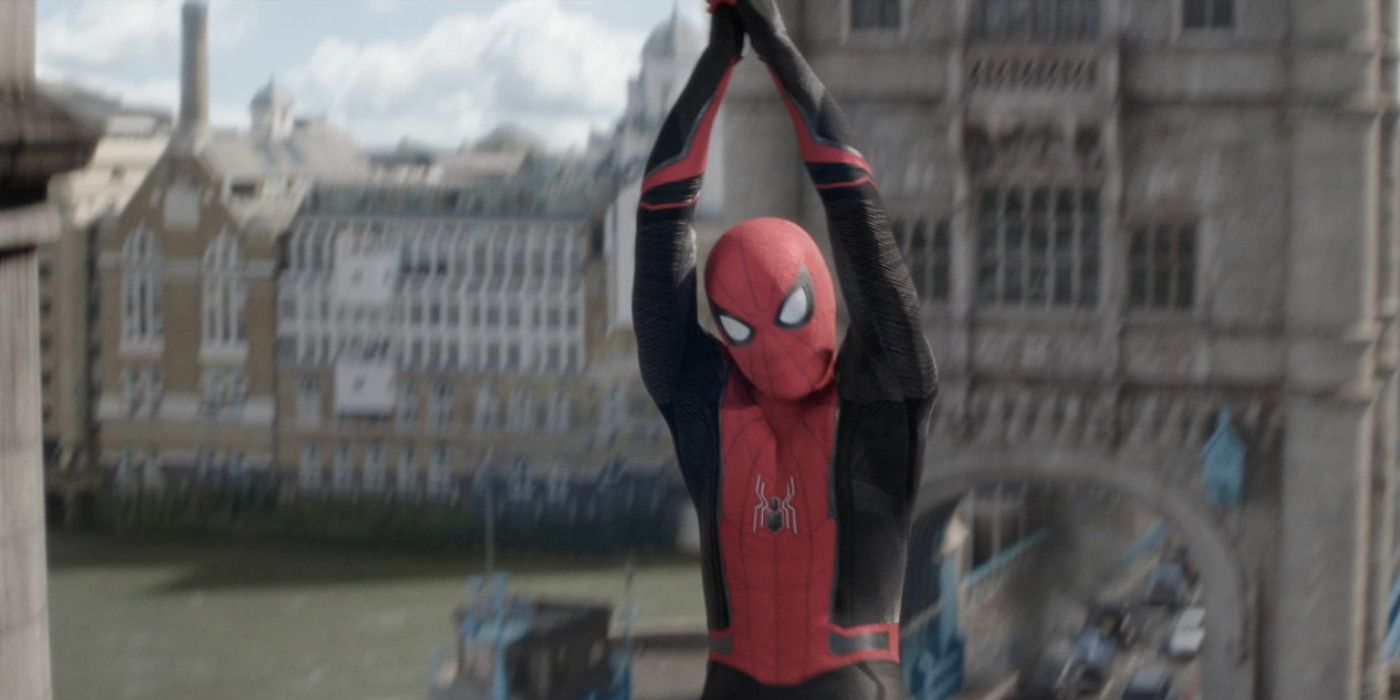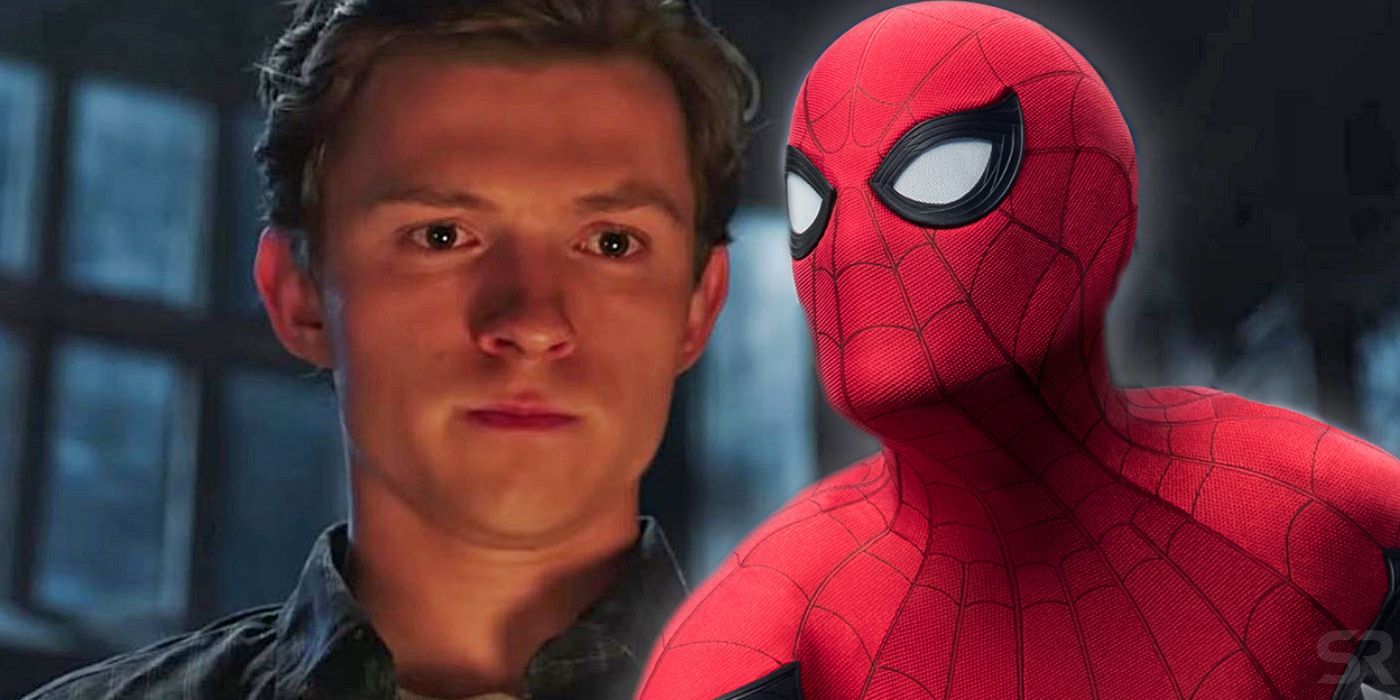Warning: This article contains SPOILERS for Spider-Man: Far From Home.
Unlike every Spider-Man adaptation so far, Spider-Man: Far From Home uses his burgeoning Spider-Sense as an integral part of his character arc. Out of all of Peter Parker’s unique and unusual superpowers, none is more curious than his Spider-Sense, the precognitive warning system that increases Spider-Man’s spatial awareness and alerts him to danger. Famously denoted by a halo of jagged lines around Peter’s head, the Spider-Sense certainly comes in handy when he’s web slinging, negotiating risky situations or dodging the attacks of criminals and super villains. Yet for all its benefits, this power is not infallible.
Thanks to the multitudes of writers and editorial teams that have crafted Spider-Man’s stories in comics and films, the precision and strength of Spider-Man’s Spider-Sense has varied drastically. Indeed, Spider-Man has been unable to recognize what the danger is and where it is coming from, on many occasions when he had previously, and vice versa. Furthermore, some villains - such as Venom and Hobgoblin - have also discovered ways of evading or manipulating Spidey’s foresight to make him vulnerable to their attacks. Certainly, it has become a crucial fixture of Spider-Man’s iconography, and entire stories have revolved around its usage or why it has earmarked seemingly innocuous people as dangerous.
The Spider-Sense was featured in the Sam Raimi and Marc Webb movie series, with both iterations of Peter Parker gaining it alongside his other Spider-powers. Though it was erratic (often depending on the requirements of the story or fight scenes) the Spider-Sense allowed both filmmakers to employ sensational slow-motion sequences to showcase Spidey’s heightened capabilities for cinematic thrills. Yet in his four appearances across the MCU, Spidey’s Spider-Sense has not been depicted as overtly - much to the confusion of moviegoers. However, with the release of Far From Home, it’s now clear that the Spider-Sense was slowly taking on a greater importance in Peter’s (Tom Holland) larger story.
The MCU Spider-Man Always Had Spider-Sense - But Couldn’t Control It
At the beginning of Far From Home, Peter is accidentally hit in the face by a banana when May (Marissa Tomei) throws one to him. Jokingly referring to the Spider-Sense as "the Peter Tingle", May apologizes for the mistake, before questioning why Peter’s precognition failed to manifest. This is certainly ironic, given that many fans had asked the same thing prior to Spidey’s introduction in Avengers: Infinity War, which was the first film to show his Spider-Sense overtly in the MCU. Indeed, it's only upon closer inspection of Captain America: Civil War that we can notice Spider-Man’s early reactions to the attacks of Ant-Man (Paul Rudd) and Bucky Barnes (Sebastian Stan) in the popular airport battle.
Due to the lack of filmmaking fanfare at these points, it's easy to see why Kevin Feige had to confirm that Peter possessed his Spider-Sense in the MCU. Then again, Civil War had also provided a reason why Peter’s Spider-Sense was not as pronounced as his cinematic predecessors. Certainly, when Tony Stark (Robert Downey Jr.) asks Peter why he needs to wear goggles in Civil War, Peter explains that all his senses were “dialed up to 11” after the spider bite. His iconic, bug-eyed lenses prevented him from being overloaded by too much visual information, which suggested that this youthful Peter Parker was similarly struggling to use and understand his newfound, preternatural senses.
By the end of Spider-Man: Far From Home, though, Peter is in a very different position. As Spider-Man enters the top walkway of Tower Bridge, Quentin Beck/Mysterio (Jake Gyllenhaal) retreats to the opposite end, filling the corridor with a huge illusion of darkness which obscures his armed drones. Instead of trying to reach Mysterio immediately, Peter pauses with his eyes closed in concentration, then bursts into action. Moreover, Spider-Man proceeds to devastate the drones with such ferocity and precision that Mysterio can only react in desperation and fear. It's the kind of strategy that Peter has used several times in his mythos; indeed, The Spectacular Spider-Man animated series actually saw him use the same trick against Mysterio's illusions. But that iteration of Peter Parker had used his Spider-Sense many times, so why is the MCU's Spider-Man only able to do this now?
Far From Home Sees Peter Mature - And Learn Spider-Sense
Throughout Far From Home, Spider-Man is bombarded with questions about his future. A reporter demands to know if he will be the new Iron Man, and Nick Fury/ Talos (Samuel L. Jackson) inquires when he is going to “step up” as a full-time hero. If this had been asked of Peter in Civil War or the first two thirds of Spider-Man: Homecoming, we can surmise that he would have responded positively to both queries. But after his first solo adventure, and the conflict with Thanos (Josh Brolin) in Avengers: Infinity War and Avengers: Endgame, this more experienced and grief-stricken Spider-Man is not so sure.
The MCU’s Spider-Man is introduced as a teenager that has already learned the fateful lesson of power and responsibility. However, the nature of that responsibility is repeatedly called into question. Spider-Man: Homecoming initially depicted a wall-crawling hero who admired Iron Man, coveting the swanky tech and recognition that comes with being an Avenger like him. But as time progresses, Peter has witnessed the consequences of Stark’s brand of heroism. Out of his comfort zone in Europe, Peter is essentially presented with Tony’s mantle in the form of the wildly powerful AI, EDITH. Indeed, the glasses are emblematic of Iron Man’s legacy, with the huge capacity for good sitting alongside a great many ethical complications, such as hyper surveillance and an army of killer drones.
Ultimately, Peter rejects them not because he doesn’t want the responsibility, but because he has learned that it is his responsibility to not be like Iron Man. From battling the scorned “little guys” like Adrian Toomes (Michael Keaton) who Stark had harmed, to the false people like Quentin Beck who crave Iron Man’s position for the wrong reasons, Peter learns about who he truly is and what he wants to do. Maturing into the “better” hero that Iron Man envisioned, Spider-Man learns to trust in his instincts (as May encouraged him to earlier in the movie) and his own place in the world. Only then is Spider-Man able to fully harness one of his signature Spider-powers to foil Mysterio’s plans and save the day. In this way, the Spider-Sense isn't just a prerequisite for Spider-Man to immediately obtain; it's a personal power that has to be unlocked, meaning that Spidey's precognition - and his confrontation with Mysterio - are lent a sense of greater, narrative significance.
Far From Home Hints At Peter's Evolution Into The MCU's Greatest Hero
Spider-Man: Far From Home may not end with this dazzling display of Peter’s Spider-Sense, but it’s clear that this sequence is the start of a new chapter for the wall-crawling hero. Certainly, Spidey steps out of his mentor’s shadow and defeats Mysterio, crucially, with a Spider-Man costume and web shooters that he designed himself. The movie then continues to shift towards a classic Spider-Man status quo, with Peter returning to New York, starting a relationship with MJ (Zendaya), and taking her swinging through Midtown.
Admittedly there’s a new wrinkle to this story, in the form of Spider-Man’s secret identity being revealed to the public. Yet the self-realization that Spidey finds atop Tower Bridge foreshadows the greatness of the wall-crawler's future in the MCU. Moreover, across his five-movie arc, audiences have already witnessed Spider-Man’s experience and proficiency grow. In true Spidey fashion, Peter has not always been successful in his confrontations. But from his scrappy bouts of heroism in Civil War and Homecoming to facing down the Mad Titan, his army, and the threat of the Elementals, Spider-Man's combat prowess has notably improved; he has become stronger and more in-tune with his Spider-powers. Indeed, Peter was so fast and thorough in Venice that very few - if any - civilians were harmed as he chased the destructive Water Elemental through the heart of the city.
These awe-inspiring displays of compassion and supernatural skill hark back to previous portrayals of Peter Parker, where his years of experience allowed him to perform increasingly miraculous feats. For example, he was able to simultaneously take down multiple super-powered foes in the Civil War comic event and there are various jaw-dropping moments of heroism in Marvel’s Spider-Man PS4 game, which come after 10 years of crime-fighting. Given that Far From Home has performed very well at the box-office - and that Tom Holland wishes to continue playing Peter for many years to come - it seems that Spider-Man is set to flourish in the MCU for some time. Therefore, as Peter’s confidence, kindness, and capabilities rapidly increase in future movies, it’s clear that the Spider-Sense scene against Mysterio in Spider-Man: Far From Home is just the beginning, as we witness the young superhero evolve onscreen like never before.




